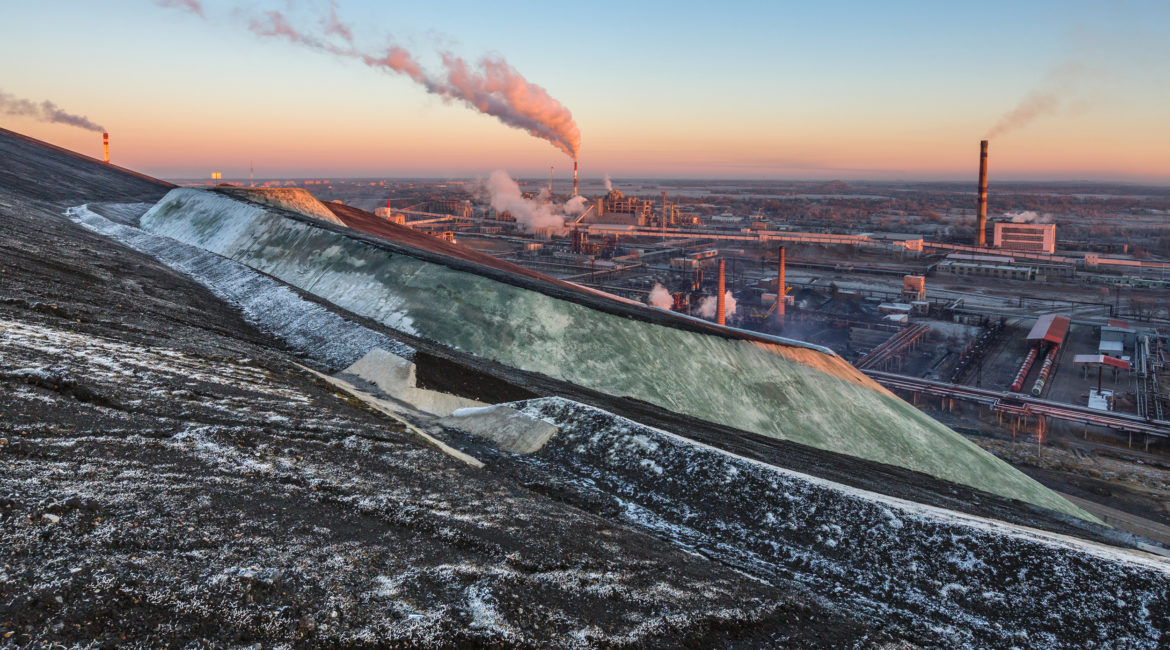A hill of mine waste amounting to 6 million m³ was relocated, 84 hectares were replanted, a rainwater collection system more than 8 km long was installed, and 2.5 hectare lakes containing liquid oil shale mining residues were closed – all part of the operation to close the Kohtla-Järve industrial waste and semi-coke dump in north-eastern Estonia. Of this amount, about 4 million cubic metres was the volume from the reconditioning of the existing Soviet-era waste tip, and the rest was earth-moving work related to the covering of the area, establishing other structures and putting out the 300,000 m³ fire. The work took place on a more than 100-hectare area, and it was made even more difficult by the fact that the work took place on steep slopes. The steepest part of the site was an area of about one hectare that was on a 45 degree slope (gradient 1:1), which was covered with a mat to prevent erosion. An area of about 11 hectares had a gradient of 1:2 and in the case of a 70-hectare area, 1:2.5. Fortunately work on the rest of the area took place in less steep conditions. In the course of covering over the dump, the area was first given its new shape specified in plans, and then the surface was compacted and levelled. To ensure that water could run along the top layer of the closed dump, it was covered with bentonite mats. To reduce the water pressure on the waterproof mineral layer and divert any run-off that filtered through the covering layer, drainage mats were used, being installed directly on the bentonite mat. On slopes at an angle of 1:2, a geo-mesh was used in addition to ensure stability of the covering layer. The geo-mesh was installed on top of the bentonite and drainage mats. Fresh semi-coke was used as the covering layer. The 6,400-metre-long collection system established around the dump serves as a collector for leachate from the hills and it is pumped into settling pools with a bottom 120,000 m² in area (volume 180,000 m³), from where it is later directed into filtration and treatment equipment. A rainwater collection system measuring about 8.2 km in length was also established on the closed dump area. This water is also directed into the settling pools. Two pumping stations and a close to 4km long pressurized pipeline from pumping station to Järve Biopuhastus waste water treatment plant were established to handle the leachate and runoff.
The works, undertaken on a very steep slope, were rendered even more complicated by smouldering fires discovered in early 2013, which were buried up to 5 metres deep. To extinguish the blaze and prevent air from reaching it, the burning areas were covered with a 2-metre-thick layer of old ash and an insulation layer composed of semi-coke with low organic content and heat conductivity. In spite of cutting off the access of air, the blaze did not go out right away, but the combustion processes slowed down, as a result of which the covering structure of the blaze area also contained a gas collection and removal layer that in turn was made up of a crushed limestone with particle size of 32-64 mm. This layer, which was over 0.5 metre thick, was left open on one side to allow gases to exit the blaze area. To ensure the water tightness of the covering layer, a covering layer of fresh semi-coke over 3 m thick had to be installed on top of it. In the case of the steep 1:1 grade, an erosion prevention mat was laid over the slope as well, following which the surface was re-vegetated by hydro-sowing. The hydro-sowing was performed over a total of about 60 hectares, and a total of about 24 hectares were planted with silver birches using hydro-sowing.
AS Merko Ehitus Eesti performed the work from December 2009 to December 2014. The contracting authority was the Ministry of the Environment, which awarded the contract at public tender to a consortium consisting of AS Merko Ehitus, AS Rand ja Tuulberg and Tallinna Teede AS.- Client:
- Keskkonnaministeerium (Estonian Ministry of the Environment)
- Name of the project:
- Closing of industrial waste and semi-coke landfill in Kohtla-Järve
- Category:
- Civil engineering
- Type of construction:
- Waste management
- Cooperation partner:
- Rand & Tuulberg AS and Tallinna Teede AS
- Description of work:
- New building
- Country:
- Estonia
- Address:
- Kohtla-Järve, Ida-Virumaa
- Beginning of the project:
- 2009
- Year of completion:
- 2014






